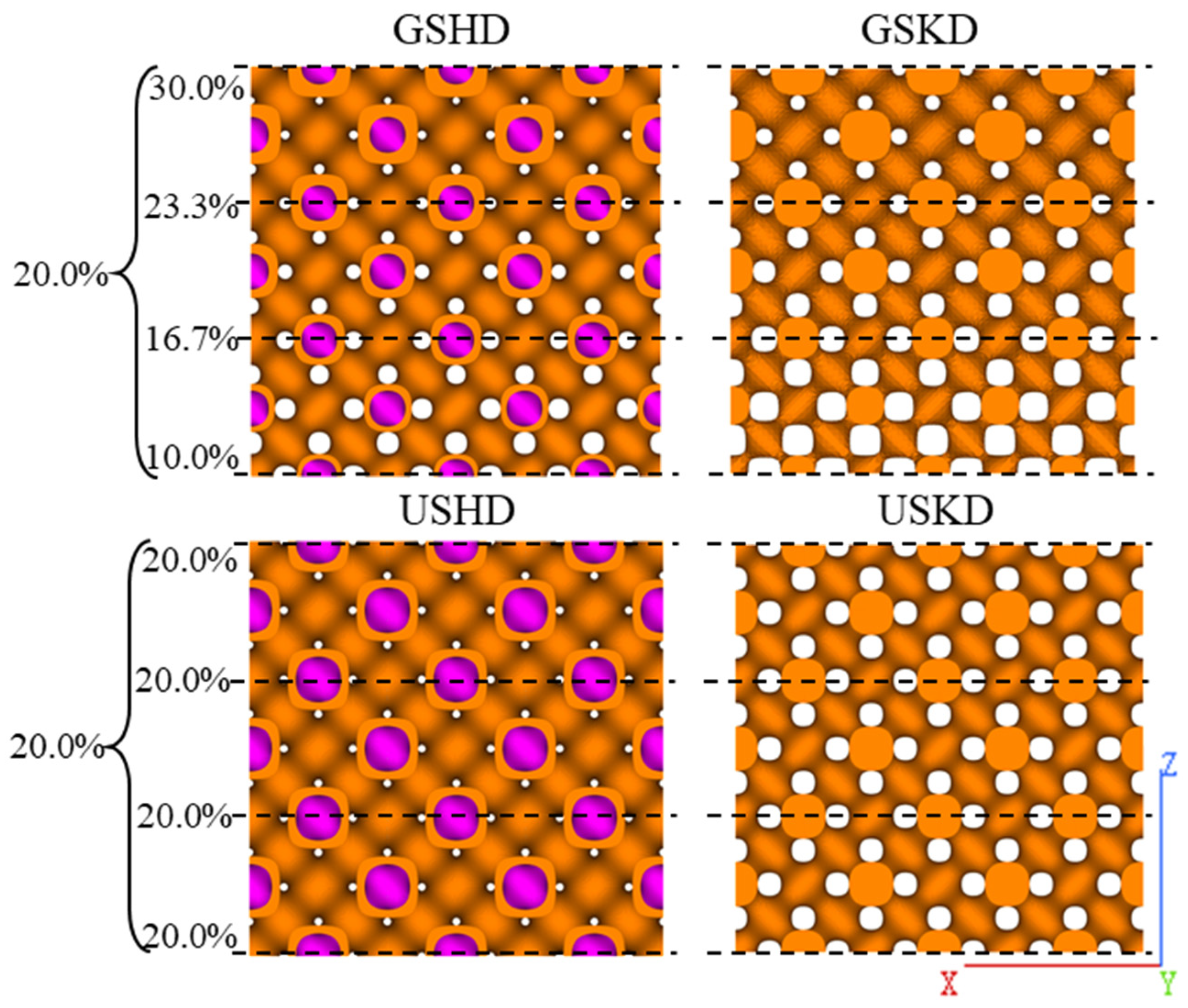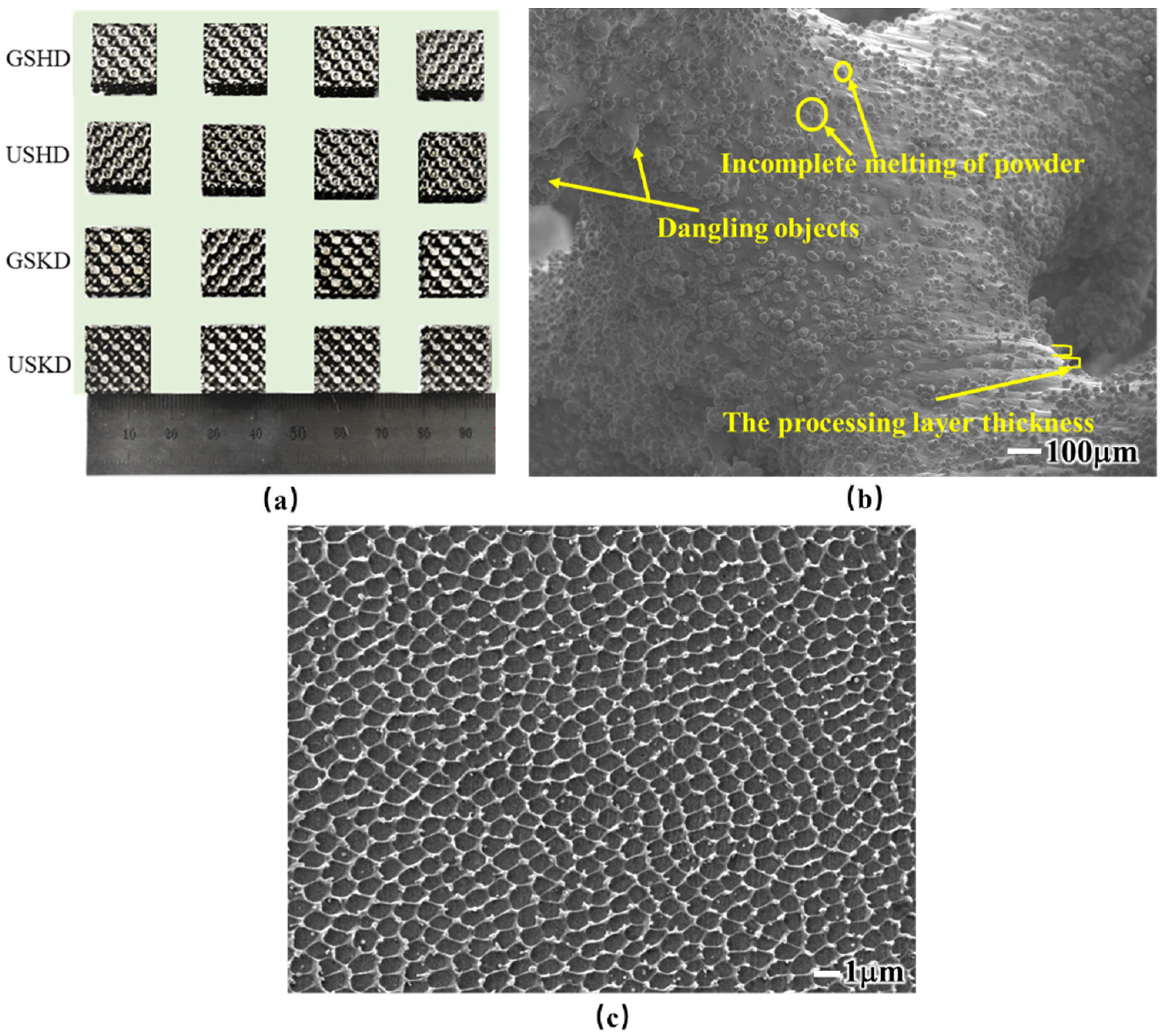Compression Behavior of SLM-Prepared 316L Shwartz Diamond Structures under Dynamic Loading
Abstract
:1. Introduction
2. Materials and Methods
2.1. TPMS Lattice Structure Design
2.2. Diamond Structure Prepared by SLM
2.3. Mechanical Properties Experiments
3. Results and Discussion
4. Conclusions
- When the strain rate was 650/s, all structures showed a stress drop, and the stress drop factor of GSKD structure was the largest, mainly because the relative density of GSKD at the beginning of deformation was the lowest and it took a long time to contact the adjacent parts.
- At nominal strain rates of 650/s, the DIF of sheet structures was higher than that of the skeleton structure, and the DIF of GSHD structure was the largest, reaching 0.98, which was the most sensitive to strain rate. Additionally, the USHD structure showed the best energy absorption capability.
- After the corresponding static SEA normalization, SEA showed different rules at ε = 0.03 and ε = 0.08, which was mainly caused by the different structural stiffness.
Author Contributions
Funding
Institutional Review Board Statement
Informed Consent Statement
Data Availability Statement
Conflicts of Interest
References
- Li, D.; Liao, W.; Dai, N.; Dong, G.; Tang, Y. Optimal design and modeling of gyroid-based functionally graded cellular structures for additive manufacturing. Comput.-Aided Des. 2018, 104, 87–99. [Google Scholar] [CrossRef]
- Wei, Q.; Li, H.; Liu, G.; He, Y.; Wang, Y.; Tan, Y.E.; Wang, D.; Peng, X.; Yang, G.; Tsubaki, N. Metal 3D printing technology for functional integration of catalytic system. Nat. Commun. 2020, 11, 4098. [Google Scholar] [CrossRef] [PubMed]
- Andrew, J.J.; Schneider, J.; Ubaid, J.; Velmurugan, R.; Gupta, N.K.; Kumar, S. Energy absorption characteristics of additively manufactured plate-lattices under low- velocity impact loading. Int. J. Impact Eng. 2021, 149, 103768. [Google Scholar] [CrossRef]
- Alzahrani, M.; Choi, S.K.; Rosen, D.W. Design of truss-like cellular structures using relative density mapping method. Mater. Des. 2015, 85, 349–360. [Google Scholar] [CrossRef] [Green Version]
- Li, P. Constitutive and failure behaviour in selective laser melted stainless steel for microlattice structures. Mater. Sci. Eng. 2015, 622, 114–120. [Google Scholar] [CrossRef]
- Cheng, X.Y.; Li, S.J.; Murr, L.E.; Zhang, Z.B.; Hao, Y.L.; Yang, R.; Medina, F.; Wicker, R.B. Compression deformation behavior of Ti-6Al-4V alloy with cellular structures fabricated by electron beam melting. J. Mech. Behav. Biomed. Mater. 2012, 16, 153–162. [Google Scholar] [CrossRef]
- Isaenkova, M.G.; Yudin, A.V.; Rubanov, A.E.; Osintsev, A.V.; Degadnikova, L.A. Deformation behavior modelling of lattice structures manufactured by a selective laser melting of 316L steel powder. J. Mater. Res. Technol. 2020, 9, 15177–15184. [Google Scholar] [CrossRef]
- Smith, M.; Guan, Z.; Cantwell, W.J. Finite element modelling of the compressive response of lattice structures manufactured using the selective laser melting technique. Int. J. Mech. Sci. 2013, 67, 28–41. [Google Scholar] [CrossRef]
- Liu, F.; Mao, Z.; Zhang, P.; Zhang, D.Z.; Jiang, J.; Ma, Z. Functionally graded porous scaffolds in multiple patterns: New design method, physical and mechanical properties. Mater. Des. 2018, 160, 849–860. [Google Scholar] [CrossRef]
- Novak, N.; Al-Ketan, O.; Krstulović-Opara, L.; Rowshan, R.; Abu Al-Rub, R.K.; Vesenjak, M.; Ren, Z. Quasi-static and dynamic compressive behaviour of sheet TPMS cellular structures. Compos. Struct. 2021, 266, 113801. [Google Scholar] [CrossRef]
- Santos, J.; Pires, T.; Gouveia, B.P.; Castro, A.P.G.; Fernandes, P.R. On the permeability of TPMS scaffolds. J. Mech. Behav. Biomed. Mater. 2020, 110, 103932. [Google Scholar] [CrossRef] [PubMed]
- Yan, C.; Hao, L.; Hussein, A.; Bubb, S.L.; Young, P.; Raymont, D. Evaluation of light-weight AlSi10Mg periodic cellular lattice structures fabricated via direct metal laser sintering. J. Mater. Process. Technol. 2014, 214, 856–864. [Google Scholar] [CrossRef]
- Yang, L.; Mertens, R.; Ferrucci, M.; Yan, C.; Shi, Y.; Yang, S. Continuous graded Gyroid cellular structures fabricated by selective laser melting: Design, manufacturing and mechanical properties. Mater. Des. 2019, 162, 394–404. [Google Scholar] [CrossRef]
- Zhang, L.; Feih, S.; Daynes, S.; Chang, S.; Wang, M.Y.; Wei, J.; Lu, W.F. Energy absorption characteristics of metallic triply periodic minimal surface sheet structures under compressive loading. Addit. Manuf. 2018, 23, 505–515. [Google Scholar] [CrossRef]
- Merrett, R.P.; Langdon, G.S.; Theobald, M.D. The blast and impact loading of aluminium foam. Mater. Des. 2013, 44, 311–319. [Google Scholar] [CrossRef]
- Deshpande, V.S.; Fleck, N.A. High strain rate compressive behaviour of aluminium alloy foams. Int. J. Impact Eng. 2000, 24, 277–298. [Google Scholar] [CrossRef] [Green Version]
- Duarte, I.; Vesenjak, M.; Krstulović-Opara, L. Variation of quasi-static and dynamic compressive properties in a single aluminium foam block. Mater. Sci. Eng. 2014, 616, 171–182. [Google Scholar] [CrossRef]
- Mukai, T.; Kanahashi, H.; Miyoshi, T.; Mabuchi, M.; Nieh, T.G.; Higashi, K. Experimental study of energy absorption in a closed-celled aluminum foam under dynamic loading. Scr. Mater. 1999, 40, 921–927. [Google Scholar] [CrossRef]
- Ozdemir, Z.; Hernandez-Nava, E.; Tyas, A.; Warren, J.A.; Fay, S.D.; Goodall, R.; Todd, I.; Askes, H. Energy absorption in lattice structures in dynamics: Experiments. Int. J. Impact Eng. 2016, 89, 49–61. [Google Scholar] [CrossRef] [Green Version]
- Yin, H.; Liu, Z.; Dai, J.; Wen, G.; Zhang, C. Crushing behavior and optimization of sheet-based 3D periodic cellular structures. Compos. Part B Eng. 2020, 182, 107565. [Google Scholar] [CrossRef]
- Park, C.; Nutt, S.R. Strain rate sensitivity and defects in steel foam. Mater. Sci. Eng. 2002, 323, 358–366. [Google Scholar] [CrossRef]
- Park, C.; Nutt, S.R. Anisotropy and strain localization in steel foam. Mater. Sci. Eng. 2001, 299, 68–74. [Google Scholar] [CrossRef]
- Zong, X.; Liu, W.; Yang, Y.; Zhang, S.; Chen, Z. Anisotropy in microstructure and impact toughness of 316L austenitic stainless steel produced by melting. Rare Metal Mater. Eng. 2020, 49, 4031–4040. [Google Scholar]
- Cao, X.; Xiao, D.; Li, Y.; Wen, W.; Zhao, T.; Chen, Z.; Jiang, Y.; Fang, D. Dynamic compressive behavior of a modified additively manufactured rhombic dodecahedron 316L stainless steel lattice structure. Thin-Walled Struct. 2020, 148, 106586. [Google Scholar] [CrossRef]
- Li, X.; Xiao, L.; Song, W. Compressive behavior of selective laser melting printed Gyroid structures under dynamic loading. Addit. Manuf. 2021, 46, 102054. [Google Scholar] [CrossRef]
- Bai, L.; Zhang, J.; Xiong, Y.; Chen, X.; Sun, Y.; Gong, C.; Pu, H.; Wu, X.; Luo, J. Influence of unit cell pose on the mechanical properties of Ti6Al4V lattice structures manufactured by selective laser melting. Addit. Manuf. 2020, 34, 101222. [Google Scholar] [CrossRef]
- Saremian, R.; Badrossamay, M.; Foroozmehr, E.; Kadkhodaei, M.; Forooghi, F. Experimental and numerical investigation on lattice structures fabricated by selective laser melting process under quasi-static and dynamic loadings. Int. J. Adv. Manuf. Technol. 2021, 112, 2815–2836. [Google Scholar] [CrossRef]
- Wang, P.F. Study on Dynamic Mechanical Response and Temperature Dependence of Porous Metals. Ph.D. Thesis, University of Science and Technology of China, Hefei, China, 2012. [Google Scholar]
- Zhao, H.; Elnasri, I.; Abdennadher, S. An experimental study on the behaviour under impact loading of metallic cellular materials. Int. J. Mech. Sci. 2005, 47, 757–774. [Google Scholar] [CrossRef]
- Atturan, U.A.; Nandam, S.H.; Murty, B.S.; Sankaran, S. Deformation behaviour of in-situ TiB2 reinforced A357 aluminium alloy composite foams under compressive and impact loading. Mater. Sci. Eng. 2017, 684, 178–185. [Google Scholar] [CrossRef]








| Alloying Element | Fe | Cr | Ni | Mo | Mn | Si | P | S | C | O |
|---|---|---|---|---|---|---|---|---|---|---|
| Wt (%) | bal | 17.16 | 12.2 | 2.71 | 1.45 | 0.56 | 0.01 | 0.008 | 0.022 | ≤0.07 |
| Structure | GSKD | GSHD | USKD | USHD |
|---|---|---|---|---|
| Dynamic increase factor (DIF) | 0.38 | 0.98 | 0.60 | 0.84 |
| Stress drop factor (λ) | 0.65 | 0.06 | 0.22 | 0.13 |
Publisher’s Note: MDPI stays neutral with regard to jurisdictional claims in published maps and institutional affiliations. |
© 2022 by the authors. Licensee MDPI, Basel, Switzerland. This article is an open access article distributed under the terms and conditions of the Creative Commons Attribution (CC BY) license (https://creativecommons.org/licenses/by/4.0/).
Share and Cite
Ma, Q.; Li, Z.; Li, J. Compression Behavior of SLM-Prepared 316L Shwartz Diamond Structures under Dynamic Loading. Crystals 2022, 12, 447. https://doi.org/10.3390/cryst12040447
Ma Q, Li Z, Li J. Compression Behavior of SLM-Prepared 316L Shwartz Diamond Structures under Dynamic Loading. Crystals. 2022; 12(4):447. https://doi.org/10.3390/cryst12040447
Chicago/Turabian StyleMa, Qingyan, Zhonghua Li, and Jiaxin Li. 2022. "Compression Behavior of SLM-Prepared 316L Shwartz Diamond Structures under Dynamic Loading" Crystals 12, no. 4: 447. https://doi.org/10.3390/cryst12040447
APA StyleMa, Q., Li, Z., & Li, J. (2022). Compression Behavior of SLM-Prepared 316L Shwartz Diamond Structures under Dynamic Loading. Crystals, 12(4), 447. https://doi.org/10.3390/cryst12040447





